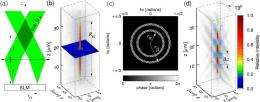October 22, 2012 report
Physics duo create tractor beam using dual Bessel beams

(Phys.org)—David Ruffner and David Grier of New York University have developed a technique for using Bessel beams to draw a particle toward a source. In their paper published in Physical Review Letters they describe how they used their technique to pull 30 micrometer sized silica spheres suspended in water, towards a laser source.
A device that uses energy to pull an object towards a source is known as a "tractor beam" after the fictional technology of Star Trek fame. To date no such device exists, but this new work by Ruffner and Grier shows that it might be possible. Their work is based on a form of laser known as a Bessel beam.
A Bessel beam, named after its creator Friedrich Bessel, is a type of laser that directs light in concentric circles around a single dot rather than as a single beam. Unlike general laser beams, the light from a Bessel beam, at the dot, is not diffracted and because the dot is formed by light from the circles, it can reform if it encounters an object in its path. It's this property that allows for pulling a particle, the team found.
Last year, a Chinese research team calculated that it should be possible to direct a Bessel beam at a particle and fine tune it in such a way as to have the light that reforms after striking the front end, reform and strike the back end, which should in theory push the particle back towards the source. The end result should look like a tractor beam.
After finding they couldn't fine tune a Bessel beam to the degree required to move a particle, Ruffner and Grier tried using two of them– with a lens that bent the beams slightly to cause them to overlap. This resulted in a strobe effect with light alternating on and off on the back end of the particle, providing enough energy to push it back towards the original light source. The end result is an apparatus that when viewed by the human eye, provides the illusion of pulling a particle towards a source device, i.e. a tractor beam.
The tractor beam the two built would require far too much energy to scale up to allow for moving large objects, and likely would destroy those objects in the process if such a device were built. But it does suggest that such a device might be possible using another less energy intensive source
More information: Optical Conveyors: A Class of Active Tractor Beams, Phys. Rev. Lett. 109, 163903 (2012) DOI:10.1103/PhysRevLett.109.163903 (Full Text)
Abstract
We experimentally demonstrate a class of tractor beams created by coherently superposing coaxial Bessel beams. These optical conveyors have periodic intensity variations along their axes that act as highly effective optical traps for micrometer-scale objects. Trapped objects can be moved selectively upstream or downstream along the conveyor by appropriately changing the Bessel beams' relative phase. The same methods used to project a single optical conveyor can project arrays of independent optical conveyors, allowing bidirectional transport in three dimensions.
Journal information: Physical Review Letters
© 2012 Phys.org

















